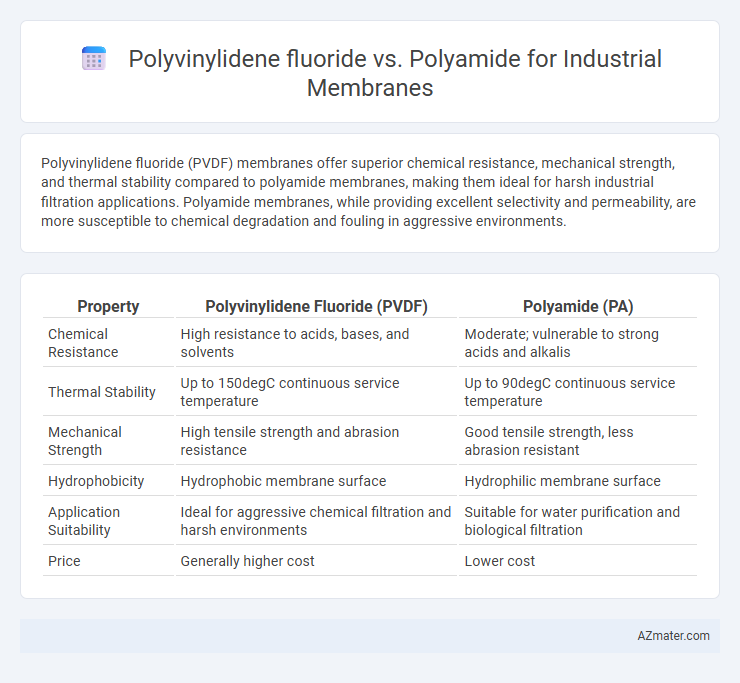Polyvinylidene fluoride (PVDF) membranes offer superior chemical resistance, mechanical strength, and thermal stability compared to polyamide membranes, making them ideal for harsh industrial filtration applications. Polyamide membranes, while providing excellent selectivity and permeability, are more susceptible to chemical degradation and fouling in aggressive environments.
Table of Comparison
| Property | Polyvinylidene Fluoride (PVDF) | Polyamide (PA) |
|---|---|---|
| Chemical Resistance | High resistance to acids, bases, and solvents | Moderate; vulnerable to strong acids and alkalis |
| Thermal Stability | Up to 150degC continuous service temperature | Up to 90degC continuous service temperature |
| Mechanical Strength | High tensile strength and abrasion resistance | Good tensile strength, less abrasion resistant |
| Hydrophobicity | Hydrophobic membrane surface | Hydrophilic membrane surface |
| Application Suitability | Ideal for aggressive chemical filtration and harsh environments | Suitable for water purification and biological filtration |
| Price | Generally higher cost | Lower cost |
Introduction to Industrial Membranes
Polyvinylidene fluoride (PVDF) and Polyamide (PA) are prominent materials used in industrial membranes for filtration applications. PVDF membranes exhibit excellent chemical resistance, thermal stability up to 150degC, and outstanding mechanical strength, making them ideal for harsh environments and aggressive solvents. Polyamide membranes offer superior selectivity and permeability for water treatment but have lower chemical resistance and thermal limits around 80degC, affecting their durability in certain industrial processes.
Overview of Polyvinylidene Fluoride (PVDF)
Polyvinylidene fluoride (PVDF) is a high-performance fluoropolymer widely used in industrial membrane applications due to its exceptional chemical resistance, thermal stability, and mechanical strength. PVDF membranes exhibit superior hydrophobicity and fouling resistance compared to polyamide membranes, making them ideal for harsh environments such as wastewater treatment and chemical processing. The polymer's semi-crystalline structure contributes to enhanced durability and prolonged membrane lifespan under aggressive operating conditions.
Overview of Polyamide (PA)
Polyamide (PA) membranes are widely used in industrial applications due to their exceptional mechanical strength, thermal resistance, and excellent chemical stability. These membranes demonstrate high permeability and selectivity for filtration processes, making them ideal for water treatment, gas separation, and solvent recovery. Polyamide's resistance to hydrolysis and fouling enhances operational durability in harsh industrial environments compared to materials like Polyvinylidene fluoride (PVDF).
Chemical Resistance: PVDF vs Polyamide
Polyvinylidene fluoride (PVDF) exhibits superior chemical resistance compared to polyamide, making it more suitable for harsh industrial environments involving strong acids, bases, and solvents. PVDF membranes maintain structural integrity and performance stability in aggressive chemical conditions, whereas polyamide membranes commonly suffer from degradation and hydrolysis when exposed to similar substances. This enhanced chemical resistance of PVDF results in longer membrane lifespan and reduced maintenance costs in industrial filtration applications.
Mechanical Strength Comparison
Polyvinylidene fluoride (PVDF) exhibits superior mechanical strength compared to polyamide (PA) in industrial membrane applications, offering enhanced tensile strength and better resistance to abrasion and impacts. PVDF membranes maintain structural integrity under high-pressure operations, whereas polyamide membranes are more prone to mechanical degradation and reduced durability over time. This makes PVDF the preferred choice for demanding industrial environments requiring long-lasting, mechanically robust membranes.
Thermal Stability and Operating Conditions
Polyvinylidene fluoride (PVDF) exhibits superior thermal stability with an operating temperature range up to 150degC, making it ideal for high-temperature industrial membrane applications. In contrast, polyamide membranes typically withstand temperatures only up to 45-60degC, limiting their use in processes requiring elevated heat resistance. PVDF's enhanced chemical and thermal durability ensures reliable performance in harsh operating conditions, while polyamide membranes are better suited for lower-temperature, less aggressive environments.
Membrane Fouling and Cleaning
Polyvinylidene fluoride (PVDF) membranes exhibit superior fouling resistance compared to polyamide (PA) membranes, due to their hydrophobic nature and chemical stability, which reduce organic and biofouling accumulation. PVDF membranes tolerate aggressive cleaning agents such as chlorine and alkaline detergents, enabling more effective fouling removal without structural damage, whereas polyamide membranes are more sensitive to pH extremes and oxidants, limiting cleaning options. This difference in fouling resistance and cleaning compatibility makes PVDF membranes preferable for industrial applications requiring frequent cleaning cycles and prolonged operational stability.
Permeability and Selectivity Performance
Polyvinylidene fluoride (PVDF) membranes exhibit superior chemical resistance and mechanical strength, resulting in higher permeability rates for industrial applications compared to polyamide membranes. Polyamide membranes, known for their exceptional selectivity, offer enhanced salt rejection and solute separation efficiency in desalination and filtration processes. The choice between PVDF and polyamide depends on balancing permeability needs with selective separation performance, where PVDF excels in durability and flux, while polyamide delivers precise molecular discrimination.
Cost Analysis: PVDF vs Polyamide
Polyvinylidene fluoride (PVDF) membranes generally exhibit higher upfront costs compared to polyamide membranes due to their superior chemical resistance and durability in industrial applications. Polyamide membranes offer a more economical choice initially but may incur higher replacement and maintenance expenses over time due to their lower chemical and thermal stability. Evaluating total cost of ownership reveals PVDF membranes as a cost-effective solution for long-term industrial use, particularly in aggressive chemical environments.
Application Suitability in Industrial Processes
Polyvinylidene fluoride (PVDF) membranes exhibit exceptional chemical resistance and thermal stability, making them highly suitable for aggressive industrial processes such as chemical filtration and wastewater treatment. Polyamide membranes demonstrate superior selectivity and high rejection rates for dissolved salts, which are ideal for reverse osmosis and desalination applications in industries requiring precise molecular separation. Selecting between PVDF and polyamide depends on process-specific factors like chemical exposure, temperature tolerance, and desired filtration performance.

Infographic: Polyvinylidene fluoride vs Polyamide for Industrial Membrane
 azmater.com
azmater.com